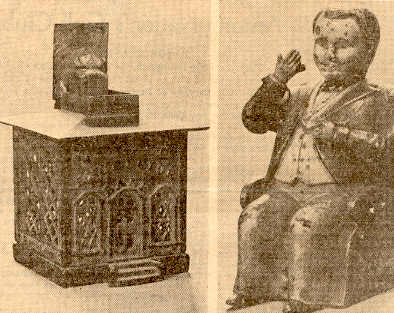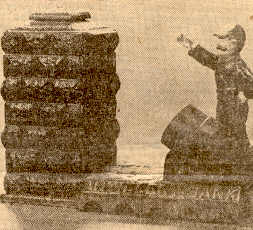THE BRIDGEPORT SUNDAY POST, JUNE 3, 1945
Children's Mechanical Banks Now
Collectors Items;
Library Holding Exhibition of Fascinating Models
Back in the Victorian era, when children were
seen and not heard and when , if we can believe many a present-day child
psychiatrist, the poor lambs had nothing done for their entertainment, a
vast number of mechanical toys were manufactured sold and presumably
presented to children.

Hall's Excelsior Bank, patented Dec. 1,
1869, is the earliest known patented type of mechanical savings bank —
delight of the youth of the Victorian era and the collectors of today.
When you pull the doorbell, the roof opens and reveals a figure seated
on a table. It overbalances, penny is "deposited" and bank
closes. Property of Edward Welch, of Barnum avenue, now on exhibition at
the Bishop Room, Buroughs Library.
Let's hope the owners of Tammany Banks — and there were many for the
form was exceedingly popular with the youth of grandpa's day — didn't
model their careers on the effigy's example. He's Boss Tweed, of course,
New York politico whose ability at slipping wealth into his own pocket
inspired the bank's designer. Put a penny in the outstretched hand and
before you can say "Boo" it's in Tweed's pocket. Justice
caught up with the original, and he died in jail in 1878 but the
popularity of the Tammany Bank continued for years.
Now, in this enlightened age, these same little
gadgets have come into a new glory and are eagerly sought by grown men
and women of the genus "collector".
An interesting group of mechanical toys
including a number of mechanical banks, is now on exhibition in the
Bishop Room of the Burroughs library, placed there on loan by Edward
Welch, of 1195 Barnum avenue.
There are games, such as "Around the World
in 73 Days with Nellie Bly" - one of those games you play by
spinning a spinner, then counting out the number of spaces with a little
marker like chessmen and he who gets around first, wins.

Pull-toys from Mr. Welch's collection are
also on display. This dog-and-cat fight actually operates the pup
dashing out of the kennel as the wheels revolve. Mistress Puss is
stationary.
There are carved animals and pull-toys of all
sorts including a fascinating cat-and-dog fight. This is a little
cast-iron toy on wheels. The cat is stationary but the dog is on a slide
so constructed that when the wheels turn he leaps out fiercely at
Mistress Pussy. There is a fine old "train-of-cars" set,
purporting to be the New York Central & Hudson River line, which has
combined a baggage and smoker with doors that really open! And so on.

For the military-minded, the Artillery
Bank! The penny is ammunition of course. Load the cannon, pull the
trigger, and the missile shoots forward and into the safety of the
tower. The iron artilleryman doesn't have any part in the performance
beyond looking military!
But the banks are the most fun. Toy-bank
collecting has become increasingly popular over recent years. When the
rage started a decade or two ago, collectors merely tried to get
together as many different types as possible. Then, as in the course of
any field of collecting, some commenced looking into the background of
various types, in order to classify them accurately.
And here, as in few other collecting fields,
there was one source of information which told very definitely when and
where and by whom many of the banks were invented and made - the
government Patent Office here for many years, inventors were obliged to
deposit working models along with drawings of objects for which patents
were desired.
Most mechanicals banks were patented, and thus
a fine picture of the trade, or art, or craft as you may chose to
classify it is available. According to H. Blair Hull, toy-bank
authority, who has investigated the records, a rather simple little item
known as "Hall's Excelsior Bank" is the earliest patented
example. The patent date is Dec. 1, 1869, and the patenter was John
Hall, of Watertown, Mass., who was late to turn out a number of other ingenious
little penny-savers.
How Bank Works
An example of Hall's Excelsior Bank is on view
at the library. It is in the form of a bank building, with hipped roof
and cupola. When the doorbell at the front entrance is pulled, the
cupola section flies open, and a little figure seated on a table, is
revealed. You place your penny on the table which over-weights the swing
section, dumps the penny in the bank and restores the roof to its
original appearance.
The patent shows the figure, which was made of
wood, to be that of a man. But many of the extant examples of this bank
show a little wooden monkey instead. On many, too, only the torso of the
figure remains, for the wood was fragile. The bank on display at the
library is, alas, minus the head.
Another intriguing type on display at the
library, which has more than a little Victorian humor in its design, is
known as the Tammany Bank and was also made by Hall, of Watertown. The
patent date was 1873.
The Tammany bank is a figurine of a political
figure of the 1860's Boss Tweed himself! Round and well-fed in
appearance and mighty elegant of long mustachios, he is reproduced in
iron dignity. The right arm is hinged. You put your penny in the
outstretched hand, the arm overbalances, and quick like a mouse Tweed
slips the penny in his own pocket!
The patent date is Dec. 23, 1873 - two years
after Tweed had been indicted for felony, discharged by a disagreeing
jury, then rearrested, convicted and sentenced to 12 years hard labor.
Tweed later escaped to Cuba and Spain, but was eventually returned
aboard a U.S. warship and died in jail in1878.
The fact that Boss Tweed banks are found fairly
frequently today suggests that they were made by the thousands and
continued their popularity long after the original of the design had
stopped putting pennies and other coins in his own pocket.
In 1941 when Hull wrote on toy banks for
Antiques Magazine, no example of a type which would be of particular
interest to local folk had been discovered. Perhaps one has since been
found. Perhaps there are a dozen still hiding on the dusty rafters of
local attics, for this type - the Slogan Bank - was patented by a
Bridgeporter.
His name was "F. W. Smith, and the
patent was obtained March 8, 1870. At least one must have been made for
submission to the patent office.
This little money-saver was in form of a square
building with a door at each of the four sides. Over the door was a
panel on which, when you deposited your penny, appeared one of the
following slogans, "Give Me a Penny," "Thank You",
"One More" and "Do It Again".
These are only a few of the types made. On
display at the library is the beloved colored jockey who rides a firery
iron steed. Put your penny in the jockey's mouth and touch off the
level. The horse will rear, the jockey be tossed forward, and the penny
will descend into the comparative safe-keeping of the chamber below. Of
course, with this as with most toy banks, you CAN get your money back by
simply removing a few screws.
Then there is the Artillery Bank which shoots
the penny into a safe-deposit section when a cannon is set off. And the
little colored boy who gets kicked in the head by the horse he is
shoeing when a penny is set in place and the lever pulled. There's the
organ bank with performing monkey, dog and cat which also plays a tune
as you make a deposit.
And so on. All are ingenious. All are extremely
charming. And by and large, you decide as you examine them, that while
they may offer less protection than present-day crack-proof dime
collecting banks, they were also a lot more fun. You didn't have to wait
till you were grown up to get something for your savings!
|



